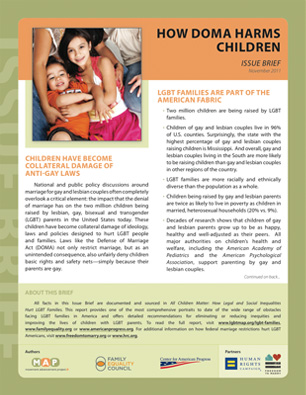The Bottom Line
National and public policy discussions around marriage for gay and lesbian couples often completely overlook a critical element: the impact that the denial of marriage has on the two million children being raised by lesbian, gay, bisexual and transgender (LGBT) parents in the United States today. These children have become collateral damage of ideology and laws—like the Defense of Marriage Act (DOMA)—designed to hurt LGBT people and families.
How DOMA Harms Children, an issue brief distilling facts documented and sourced in All Children Matter: How Legal and Social Inequalities Hurt LGBT Families, examines and explores specific ways in which DOMA unfairly denies children basic rights and safety nets, just because their parents are gay.
- Issue Brief: How DOMA Harms ChildrenDownload


